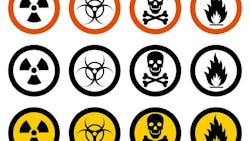In 2023, OSHA wrote citations for an astounding 3,213 violations related to hazard communication systems (HCSs). That number is not as astounding as the 7,271 violations for fall protection in the same year. Fall protection took the No. 1 spot, and HCS took a distant second. What is astounding is that there could be so many violations for this particular part of OSHA regulations.
The HCS regulations are covered in 29CFR1910.1200. It breaks down into these subparts:
(a) Purpose.
(b) Scope and applications.
(c) Definitions.
(d) Hazard classification.
(e) Written hazard communication program.
(f) Labels and other forms of warning.
(g) Safety data sheets.
(h) Employee information and training.
(i) Trade secrets.
(j) Effective dates.
For the typical employer getting cited and fined, what’s missing is a decent implementation of d, e, and h from that list. This is where the citations start accruing. But at root is a failure to understand a, b, and c from that list. In this multi-part series, we’ll cover each of those.
Let’s start with the purpose. There are really two of them:
- To ensure that the hazards of chemicals that employees may be exposed to are identified and classified.
- To ensure that the information concerning those chemical hazards is communicated to the employees.
Look at that purpose again, and you can see why 3,213 violations is an astounding number. HCS is not a big ask and yet failure to comply is endemic. The purpose of this multi-part article is to give you the information you need to ensure your company isn’t among those cited.
About the Author

Mark Lamendola
Mark is an expert in maintenance management, having racked up an impressive track record during his time working in the field. He also has extensive knowledge of, and practical expertise with, the National Electrical Code (NEC). Through his consulting business, he provides articles and training materials on electrical topics, specializing in making difficult subjects easy to understand and focusing on the practical aspects of electrical work.
Prior to starting his own business, Mark served as the Technical Editor on EC&M for six years, worked three years in nuclear maintenance, six years as a contract project engineer/project manager, three years as a systems engineer, and three years in plant maintenance management.
Mark earned an AAS degree from Rock Valley College, a BSEET from Columbia Pacific University, and an MBA from Lake Erie College. He’s also completed several related certifications over the years and even was formerly licensed as a Master Electrician. He is a Senior Member of the IEEE and past Chairman of the Kansas City Chapters of both the IEEE and the IEEE Computer Society. Mark also served as the program director for, a board member of, and webmaster of, the Midwest Chapter of the 7x24 Exchange. He has also held memberships with the following organizations: NETA, NFPA, International Association of Webmasters, and Institute of Certified Professional Managers.
